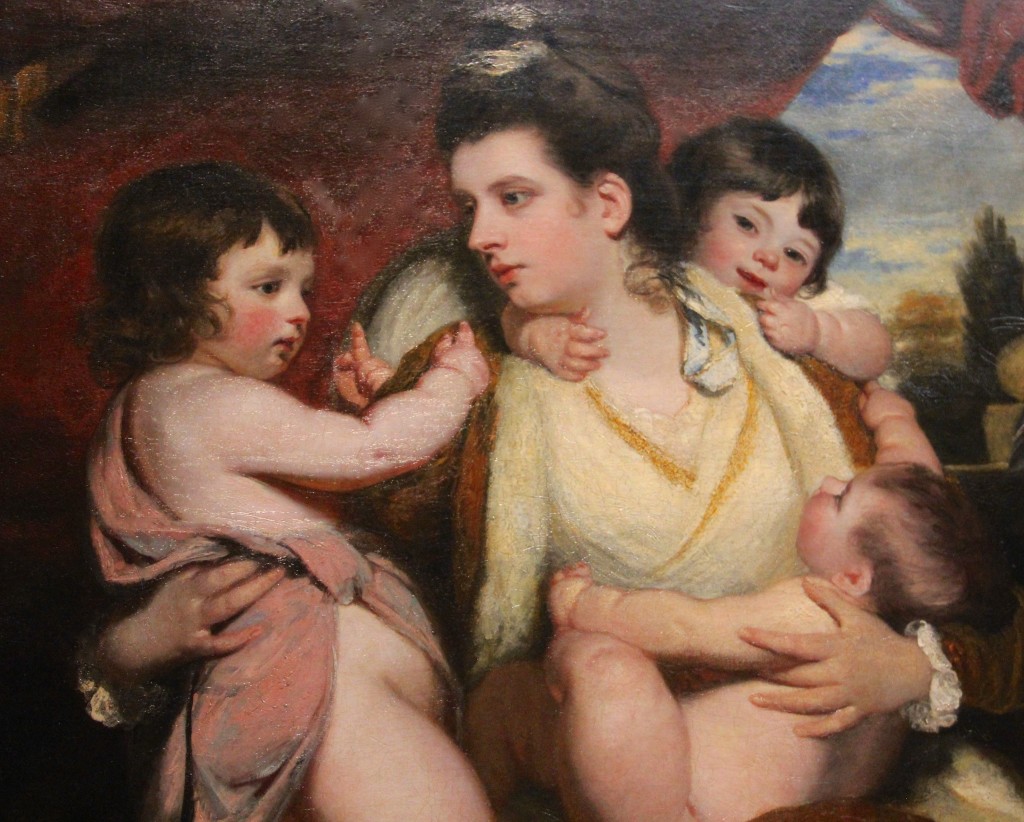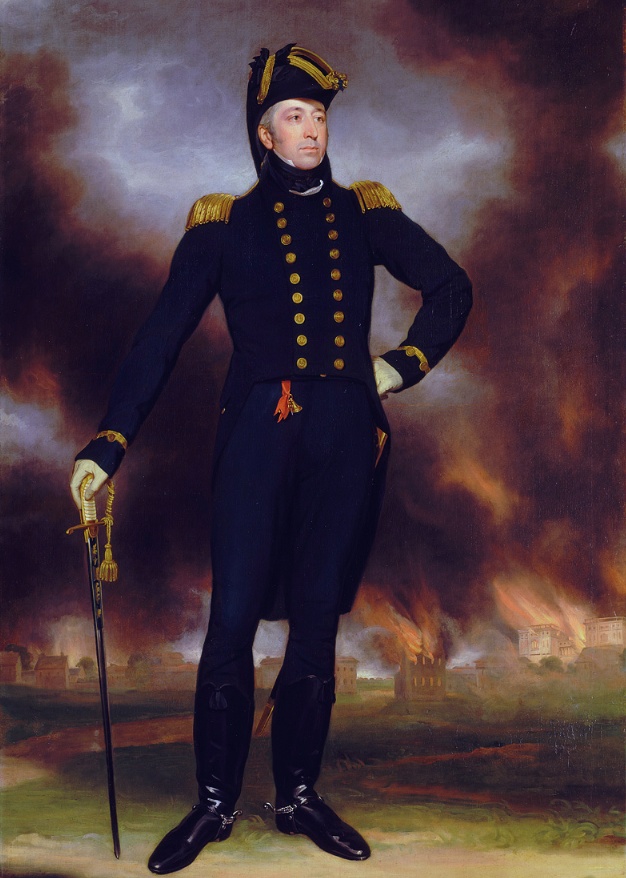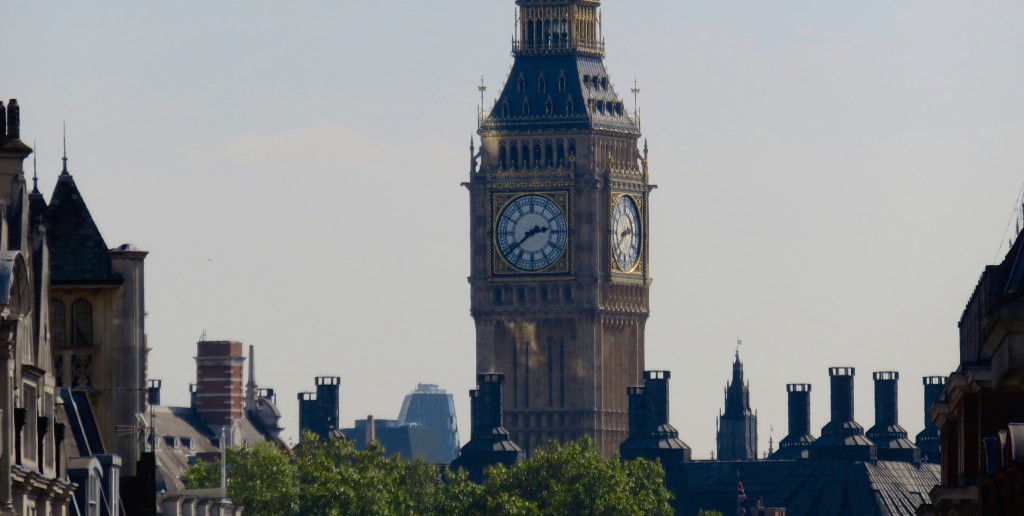The more you learn about Napoleon Bonaparte the more likely you are to find connections to him. As I mentioned in my last blog post, “Finding Napoleon” was particularly easy during my recent trip to London. Still, here’s a London connection among Napoleon Bonaparte, the burning of the American capital during the War of 1812, and my sixth grade school that surprised me.
This charming family portrait hangs in London’s National Gallery. The museum’s identification card lists the artist as Sir Joshua Reynolds and the subject as “Lady Cockburn and her Three Eldest Sons, 1773.” When I read the children’s names, I realized that the darling cherub peeking over his mother’s shoulder was none other than the future Admiral Sir George Cockburn who, at age 43, escorted Napoleon Bonaparte to his exile on St Helena Island.
 According to many reports from the time, Napoleon and his head jailer did not always see eye-to-eye. First, Admiral Cockburn immediately implemented the British policy of denying Napoleon his imperial title. Henceforth, he insisted, the former emperor was to be addressed as “General.” More than that, in a effort to delegitimize his right to lead the French, the British used the Corsican spelling of his name so “Bonaparte” reverted to the Italian-sounding “Buonaparte.” Napoleon himself refused to play the role as prisoner. He reasoned, if he were a prisoner of war, well then, those wars were over and, by international accord, all prisoners were to be released. Moreover, by European tradition, deposed sovereigns were granted dignified asylum. Why should he be treated any differently?
According to many reports from the time, Napoleon and his head jailer did not always see eye-to-eye. First, Admiral Cockburn immediately implemented the British policy of denying Napoleon his imperial title. Henceforth, he insisted, the former emperor was to be addressed as “General.” More than that, in a effort to delegitimize his right to lead the French, the British used the Corsican spelling of his name so “Bonaparte” reverted to the Italian-sounding “Buonaparte.” Napoleon himself refused to play the role as prisoner. He reasoned, if he were a prisoner of war, well then, those wars were over and, by international accord, all prisoners were to be released. Moreover, by European tradition, deposed sovereigns were granted dignified asylum. Why should he be treated any differently?
Needless to say, the British and their allies didn’t buy those arguments. Admiral Cockburn delivered Napoleon to St Helena on October 16, 1815. He stayed on the island long enough to turn over custody of Europe’s most famous prisoner to the island’s new governor, Sir Hudson Lowe.
The connection to the burning of my country’s capital? A year before escorting Napoleon to St Helena, Admiral Cockburn had been second-in-command of the British naval forces in the War of 1812. For two years, he had waged war against American ships and ports in the Chesapeake Bay.
 On August 24, 1814, following orders that included “laying waste to towns,” he led the torching of Washington. The White House, the Library of Congress, and the Capitol were all but destroyed. You can see the city burning in this portrait of Cockburn by John James Hall, now in the Royal Museum in Greenwich, England.
On August 24, 1814, following orders that included “laying waste to towns,” he led the torching of Washington. The White House, the Library of Congress, and the Capitol were all but destroyed. You can see the city burning in this portrait of Cockburn by John James Hall, now in the Royal Museum in Greenwich, England.
And my sixth grade school? I was living in France and gaining my first knowledge of Napoleon. As a US Navy dependent, I attended a small school named after the American naval hero, Commodore Joshua Barney.
In the summer of 1814, Commodore Barney led a US Navy flotilla in the Chesapeake Bay, causing Admiral Cockburn a great deal of trouble.
Unfortunately for Commodore Barney, Napoleon Bonaparte’s future jail warden had the last word: Barney had to scuttle his fleet to avoid its capture. He and his troops joined in the defense of Washington under the personal leadership of President Madison. Ultimately, all fled in what was deemed at the time to be the American military’s greatest humiliation. It took the September Battle of Baltimore—which is memorialized in “The Star Spangled Banner”—to turn the tide against Cockburn’s navy.


Did Cockburn speak French? When I find out, my next post gets very interesting…
I believe that he did. When I get a chance, maybe I can find a source for you to confirm it. I’m interested in why it matters to you.
Take care,
Margaret
I have a set of French Gentleman’s Dictionairres, copyright 1805, with Cockburn’s bookplate inside the cover of each volume.
I believe they were Bonaparte’s and Cockburn somehow ended up with them. Perhaps a token gifting while on the Northumberland or while on St Helena. They were once catalogued at Notre Dame.
Interesting. I can’t get Sotheby’s or The Royal Navy Archives to take interest.
They sound like a wonderful possession. I’m not a Napoleonica collector so I can’t tell you what they might be worth or where to sell them. It may be hard without papers showing ownership or provenance over the years. The U.S and Canada Napoleonic Historical Society does have a “marketplace” on its website https://napoleonichistoricalsociety.org. You might try listing them there as long as you are open about the speculation of their prior ownership.
All the best,
Margaret
After Commodore Barney destroyed his fleet he and his sailors marched to Old Fields Maryland, the HQ of the gathering American force. Barney brought with him artillery, arms and ammunition. During the Battle of Bladensburg he and his men held the line while the others on the front lines ran. After two assaults on the American lines a third charge by Cockburn forced Barney’s men to retreat. The Commodore was wounded and lay on the ground tended to by one of his men. Cockburn spoke to him. The Admiral said he knew that the stiffest resistance from the Americans must be from Barney’s and his sailors.
David, when I lived in France as a US Navy officer’s daughter, my grade school was named Joshua Barney Elementary. It was a new school and there had been a essay contest to determine its name. My older brother’s essay on Commodore Barney won!
Margaret